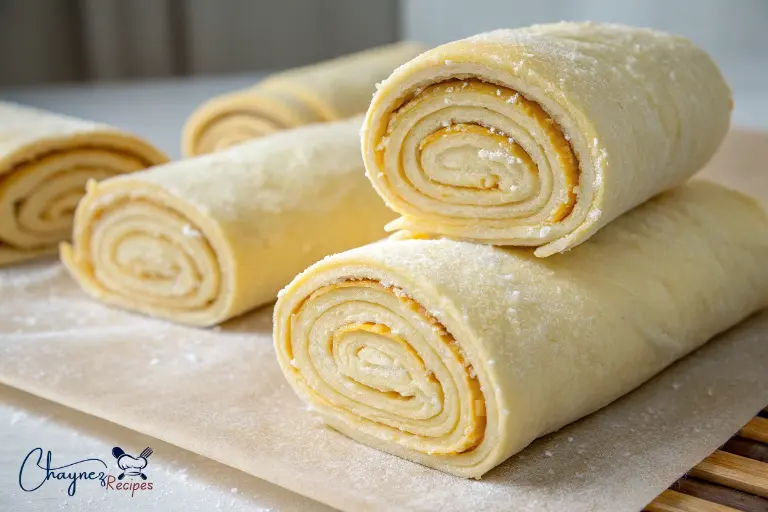When it comes to creating delicious baked goods, the choice of pastry can make all the difference. Pepperidge Farm puff pastry and phyllo dough are two popular options that often cause confusion among home bakers and even experienced chefs. While both are used to create flaky, crispy textures, they are not quite the same. If you’ve ever wondered, Is Pepperidge Farm puff pastry the same as phyllo? you’re not alone. In this article, we will break down the differences and similarities between these two pastries, helping you understand when and how to use each one to get the best results.
Although both Pepperidge Farm puff pastry and phyllo dough can be used in a wide variety of recipes, they each offer unique characteristics. From their texture and preparation methods to their versatility in savory and sweet dishes, understanding these differences can elevate your baking skills. So, if you’re unsure whether to reach for Pepperidge Farm puff pastry or phyllo dough for your next creation, keep reading to find out how each pastry behaves in the kitchen.
What is Puff Pastry?
Before comparing Pepperidge Farm puff pastry with phyllo dough, it’s essential to understand the unique qualities of puff pastry itself. Puff pastry is a flaky, buttery dough that has been crafted through a labor-intensive process of layering dough and butter. The dough is repeatedly folded and rolled, a technique known as “lamination.” This process creates hundreds of very thin layers of dough and butter that puff up dramatically when baked, resulting in the light, airy, and crispy texture that makes puff pastry a favorite in both savory and sweet dishes.
Unlike many other doughs, puff pastry doesn’t require yeast or any leavening agents to achieve its rise. Instead, the butter and steam produced during baking cause the layers to separate and expand, creating a light, delicate structure. The layers form a beautifully flaky exterior while keeping the inside tender, making puff pastry incredibly versatile.
Characteristics of Puff Pastry:
- Flaky and Tender: One of the most notable features of puff pastry is its flaky texture. The layers of dough separate and become crisp as they bake, giving the pastry a light, airy texture that contrasts beautifully with the fillings inside.
- Rich Flavor: The high content of butter in puff pastry adds a rich and slightly nutty flavor. This butter not only enhances the taste but also contributes to the pastry’s characteristic golden color when baked. The rich flavor makes it perfect for both sweet and savory recipes.
- Thicker Texture than Phyllo: Compared to phyllo dough, which is extremely thin, puff pastry is significantly thicker. This heftier texture makes puff pastry more substantial and allows it to hold its shape and support heavier fillings, like creamy chicken pot pies or rich chocolate tarts.
- Versatility: Pepperidge Farm puff pastry is particularly popular because it’s easy to use, as it comes pre-rolled and ready for baking. It can be used for everything from delicate appetizers to hearty entrees. Pepperidge Farm offers a consistent, high-quality puff pastry that takes the guesswork out of preparation, making it a staple in many home kitchens and professional bakeries alike.
How Is Puff Pastry Made?
The process of making puff pastry is one of the main factors that sets it apart from other doughs. Typically, puff pastry is made by folding a block of chilled butter into a dough mixture of flour, water, and salt. The dough is then rolled out and folded over the butter in a specific pattern, known as a “turn.” These steps are repeated several times (usually six to seven), allowing the butter to be evenly distributed throughout the dough and creating the layers.
During baking, the water in the dough turns to steam, causing the layers to rise and separate. This is what gives puff pastry its signature flaky texture. While this process requires time and patience when making from scratch, Pepperidge Farm puff pastry offers a convenient shortcut for home bakers, as it eliminates the need for the complex lamination process.
How to Work with Puff Pastry:
- Keep it Cold: Puff pastry should be kept cold until you’re ready to bake. If the dough becomes too warm, the butter may start to melt, preventing the layers from puffing up properly. For best results, work with the pastry quickly and refrigerate it if necessary between steps.
- Rolling and Cutting: When rolling out puff pastry, be careful not to overwork the dough, as this can reduce the flakiness. Use a sharp knife to cut through the dough to maintain clean edges.
- Baking: Puff pastry should be baked in a hot oven to allow the layers to puff up effectively. A temperature of around 400°F (200°C) is ideal for achieving the perfect golden-brown color and flaky texture.
By understanding the characteristics and the making process of puff pastry, it becomes easier to choose the right type of dough for different dishes and know exactly how to work with it. Whether you are using Pepperidge Farm puff pastry or making it from scratch, this dough is sure to add a rich, flaky layer to your recipes.
What is Phyllo Dough?
Phyllo dough, also known as filo dough, is another thin pastry used for many savory and sweet dishes. It is made by stretching dough into very thin sheets, which are typically brushed with butter or oil before being layered and baked.
Characteristics of Phyllo Dough:
- Thin sheets: Phyllo dough is extremely thin, almost paper-like.
- Crispy texture: Unlike puff pastry, phyllo doesn’t have layers that separate but instead creates a crisp, flaky texture when baked.
- Delicate: Because it’s so thin, phyllo dough requires careful handling to avoid tearing.
How Are Puff Pastry and Phyllo Dough Different?
Now that we know what each dough is, let’s dive into the key differences between Pepperidge Farm puff pastry and phyllo dough.
1. Texture and Structure
- Puff Pastry: Puff pastry is thick and buttery. The layers puff up during baking, creating a light, airy texture that’s crisp on the outside and tender on the inside.
- Phyllo Dough: Phyllo dough is extremely thin and delicate. It becomes crispy once baked, but it doesn’t puff up in layers the way puff pastry does. Instead, the layers stay flat, creating a crunchy texture.
2. Preparation Process
- Puff Pastry: Making puff pastry from scratch requires folding butter into dough repeatedly to create layers. This is a time-consuming process, but Pepperidge Farm puff pastry is pre-rolled, making it quick and convenient to use for home bakers.
- Phyllo Dough: Phyllo dough is typically bought in thin sheets, which require careful handling. It doesn’t require layers of butter, but each sheet must be brushed with butter or oil to create the desired crisp texture.
3. Fat Content
- Puff Pastry: Puff pastry contains a significant amount of butter, which contributes to its rich flavor and texture.
- Phyllo Dough: Phyllo dough is lower in fat because the dough itself doesn’t include butter or oil. Instead, fats are added by brushing each sheet individually.
4. Baking Behavior
- Puff Pastry: When baking, puff pastry rises significantly, creating distinct layers. The butter in the dough helps it rise and gives it a tender texture.
- Phyllo Dough: Phyllo dough doesn’t rise, but the multiple layers crisp up as they bake, creating a different kind of texture, crunchy rather than puffy.
Is Pepperidge Farm Puff Pastry the Same as Phyllo?
While they may appear similar because they are both used to create flaky, crispy pastries, Pepperidge Farm puff pastry and phyllo dough are quite different. The most important distinctions come in the texture, fat content, and the way they are prepared.
Main Differences:
- Puff Pastry: Flaky, buttery, thick, rises during baking.
- Phyllo Dough: Thin, delicate, crispy, and doesn’t rise.
Understanding these differences will help you decide which pastry to use for your next recipe.

When to Use Pepperidge Farm Puff Pastry
Puff pastry is ideal for dishes that need a rich, buttery flavor and a flaky, airy texture. It’s perfect for both sweet and savory recipes, such as:
- Tarts: Use puff pastry as the base for a fruit tart or a savory tart.
- Pastries: Whether you’re making turnovers, Danish pastries, or croissants, puff pastry provides a light and flaky texture.
- Pot Pies: Puff pastry makes a perfect crust for pot pies, offering a hearty, flaky exterior.
Tips for Using Puff Pastry:
- Always keep it cold until you’re ready to bake it. This ensures the butter stays solid and the layers separate.
- Use a sharp knife to cut puff pastry to avoid squashing the layers.
- Don’t overhandle the dough, as this can make it tough.
When to Use Phyllo Dough
Phyllo dough is excellent for recipes that require a crispy, crunchy texture. It’s perfect for dishes like:
- Baklava: The delicate layers of phyllo dough create the signature crunch in this popular Middle Eastern dessert.
- Spanakopita: This savory Greek dish is made by layering phyllo dough with spinach and feta filling.
- Strudel: Phyllo dough is often used for sweet or savory strudels, especially in European baking traditions.
Tips for Using Phyllo Dough:
- Work quickly to prevent the dough from drying out. Cover unused sheets with a damp towel.
- Brush each sheet of phyllo with butter or oil to ensure it crisps up nicely during baking.
- Use multiple layers of phyllo to create a sturdy texture, as one sheet on its own can be too delicate.
Can You Substitute One for the Other?
If you find yourself with Pepperidge Farm puff pastry but need phyllo dough for a recipe, or vice versa, can they be substituted? The answer depends on the dish you’re preparing.
- Puff Pastry for Phyllo: In some cases, you can substitute puff pastry for phyllo dough, especially in savory dishes like savory pies or quiches. However, the texture will change, and the pastry will be thicker and more buttery.
- Phyllo for Puff Pastry: Substituting phyllo dough for puff pastry is trickier. Phyllo won’t rise the same way, and the resulting dish may be much crisper and lighter. For example, in a pot pie, phyllo dough wouldn’t create the same hearty, flaky crust.
Ultimately, while the two types of pastry can sometimes be swapped in a pinch, they produce different textures and flavors, and the results may not be identical.
FAQs: Is Pepperidge Farm Puff Pastry the Same as Phyllo?
1. Is Pepperidge Farm Puff Pastry the Same as Phyllo Dough?
No, Pepperidge Farm puff pastry is thicker, richer, and more buttery than phyllo dough. Puff pastry puffs up when baked, while phyllo creates a crisp, thin texture.
2. Can I Use Pepperidge Farm Puff Pastry Instead of Phyllo?
In some recipes, you can substitute puff pastry for phyllo, but the texture and appearance will be different. Puff pastry will be thicker and flakier, while phyllo will be crispier and more delicate.
3. How Do I Work with Pepperidge Farm Puff Pastry?
Keep the puff pastry cold, work quickly, and bake at a high temperature (around 400°F). This ensures the layers puff up properly and gives it a golden, flaky texture.
4. Is Puff Pastry More Fatty Than Phyllo Dough?
Yes, puff pastry contains more butter, which gives it a richer flavor and texture. Phyllo dough, on the other hand, has less fat and relies on brushing with oil or butter during preparation.
5. What Dishes Can I Make with Pepperidge Farm Puff Pastry?
You can use puff pastry for a variety of dishes, including tarts, pot pies, pastries, and turnovers. It works well for both savory and sweet recipes due to its flaky and buttery texture.
Conclusion: Is Pepperidge Farm Puff Pastry the Same as Phyllo?
So, is Pepperidge Farm puff pastry the same as phyllo? The answer is clear: no, they are distinct pastries with unique textures and characteristics. Pepperidge Farm puff pastry is a rich, buttery dough that creates light, flaky layers when baked. It’s ideal for those who want a thicker, more substantial pastry that adds flavor and texture to both savory and sweet dishes. On the other hand, phyllo dough is a much thinner, crispier option that works well for delicate, crunchy pastries and layered dishes.
Understanding the differences between these two will help you decide which pastry is best for your next recipe. Whether you’re baking a savory pot pie, creating a fruit tart, or crafting a savory appetizer, knowing the qualities of each will allow you to choose the right option for the desired texture and flavor. While Pepperidge Farm puff pastry may offer more versatility with its thicker, more robust texture, phyllo dough shines in recipes that require a lighter, crispier result.
If you’re looking for some delicious inspiration, why not try some comforting and flavorful dishes that pair perfectly with puff pastry or phyllo? Check out our Chicken Alfredo Noodle Soup, a rich and creamy soup perfect for chilly evenings. Or perhaps indulge in our Steak Alfredo Recipe, featuring juicy steak and a luscious Alfredo sauce. For a heartwarming dish with a twist, give our Chicken Alfredo Soup with Beef and Parmesan Cheese a try, a hearty, flavorful soup that combines the best of both worlds.
Quick Summary:
- Puff Pastry: Buttery, flaky, thick, rises during baking.
- Phyllo Dough: Thin, delicate, crisp, doesn’t rise.
By understanding these key differences, you can confidently choose the right pastry for your next culinary creation. Whether you’re making a savory pie or a sweet pastry, both puff pastry and phyllo dough bring their own unique qualities to your dish.
And don’t miss out on more great ideas for healthier baking and cooking. For additional tips, recipes, and updates, follow us on Chaynez Recipes to access our latest posts and social media links.






